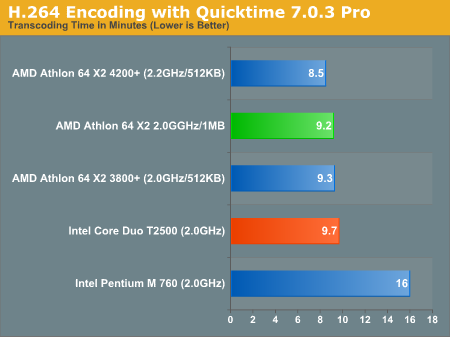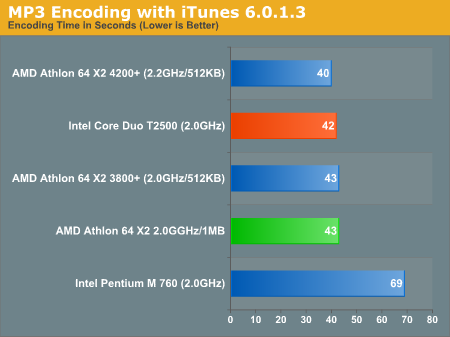Intel Core Duo (Yonah) Performance Preview - Part II
by Anand Lal Shimpi on December 19, 2005 12:55 PM EST- Posted in
- CPUs
Media Encoding Performance with DVD Shrink, WME, Quicktime and iTunes
We were most curious about the Core Duo's media encoding performance, given that a number of the optimizations for the new processor were FP/SSE related. We've updated our entire media encoding test suite, including everything from the one-click DVD ripping utility DVD Shrink to including H.264 encoding performance with Quicktime 7.0.3 Pro. We wanted to include the latest version of DivX in this comparison. However, the recent release of DivX 6.1 left us with a few bugs that we're still trying to work out in our test beds, so we had to exclude it. However, as time goes on, H.264 encoding will quickly become far more important than even looking at DivX, so its omission from this article isn't as big of a loss in terms of forward-looking performance.
First up is DVD Shrink 3.2.0.15. Our test was simple - we took a copy of Star Wars Episode VI and ripped the full DVD to the hard drive without compression, effectively giving us an exact copy of the disc on the hard drive. Then, using the copy of the DVD on the hard drive (to eliminate any DVD drive bottlenecks), we performed a DVD shrink operation to shrink the movie to fit on a single 4.5GB DVD disc. All of the options were left on their defaults, so the test ends up being pretty easy to run and reproduce. The scores reported are DVD encoding times in minutes, with lower numbers meaning better performance.
The DVD Shrink test is quite important as DVD Shrink is quite possibly one of the easiest tools to rip a DVD. The easier a tool is to use, the more likely it's going to be used, and arguably the more important performance using it happens to be.
Moving on, we have our Windows Media Encoder 9 test, which uses the advanced profile settings for video encoding. We left all settings at their defaults and just proceeded with a MPEG-2 to WMV-HD conversion. The values reported are in frames per second, with higher numbers being better.
Next up, we have Quicktime Pro 7.0.3 and we perform a MPEG-2 to H.264 encoding task. All of the settings are left at their defaults, with the exception that we optimize the output file for download with a 256kbps data rate while leaving the resolution untouched. We also adjust the video options to optimize for the best quality. We report the transcoding time in minutes, with lower values being better.
Finally, we have a MP3 encoding test using iTunes 6.0.1.3. For this test, we simply took a 304MB wav file and converted it to a 192kbps MP3 file, measuring the encode time in seconds. The only iTunes option that we changed was to prevent the playback of the song while encoding.
We were most curious about the Core Duo's media encoding performance, given that a number of the optimizations for the new processor were FP/SSE related. We've updated our entire media encoding test suite, including everything from the one-click DVD ripping utility DVD Shrink to including H.264 encoding performance with Quicktime 7.0.3 Pro. We wanted to include the latest version of DivX in this comparison. However, the recent release of DivX 6.1 left us with a few bugs that we're still trying to work out in our test beds, so we had to exclude it. However, as time goes on, H.264 encoding will quickly become far more important than even looking at DivX, so its omission from this article isn't as big of a loss in terms of forward-looking performance.
First up is DVD Shrink 3.2.0.15. Our test was simple - we took a copy of Star Wars Episode VI and ripped the full DVD to the hard drive without compression, effectively giving us an exact copy of the disc on the hard drive. Then, using the copy of the DVD on the hard drive (to eliminate any DVD drive bottlenecks), we performed a DVD shrink operation to shrink the movie to fit on a single 4.5GB DVD disc. All of the options were left on their defaults, so the test ends up being pretty easy to run and reproduce. The scores reported are DVD encoding times in minutes, with lower numbers meaning better performance.
The DVD Shrink test is quite important as DVD Shrink is quite possibly one of the easiest tools to rip a DVD. The easier a tool is to use, the more likely it's going to be used, and arguably the more important performance using it happens to be.

- The Pentium M performs exceptionally poorly, and
- The Core Duo performs exceptionally well.
Moving on, we have our Windows Media Encoder 9 test, which uses the advanced profile settings for video encoding. We left all settings at their defaults and just proceeded with a MPEG-2 to WMV-HD conversion. The values reported are in frames per second, with higher numbers being better.

Next up, we have Quicktime Pro 7.0.3 and we perform a MPEG-2 to H.264 encoding task. All of the settings are left at their defaults, with the exception that we optimize the output file for download with a 256kbps data rate while leaving the resolution untouched. We also adjust the video options to optimize for the best quality. We report the transcoding time in minutes, with lower values being better.

Finally, we have a MP3 encoding test using iTunes 6.0.1.3. For this test, we simply took a 304MB wav file and converted it to a 192kbps MP3 file, measuring the encode time in seconds. The only iTunes option that we changed was to prevent the playback of the song while encoding.

Professional Application Performance with 3dsmax, Adobe Premier and Photoshop
Gaming Performance with Battlefield 2 and Black & White 2










103 Comments
View All Comments
Hacp - Monday, December 19, 2005 - link
If you want performance of an AMD X2 in a notebook package, the Yonah duo is the way to go.Griswold - Monday, December 19, 2005 - link
Or you wait for dual core Turion. Same thing.Accord99 - Monday, December 19, 2005 - link
But at 2-3x the power consumption.Houdani - Monday, December 19, 2005 - link
http://www.anandtech.com/cpuchipsets/showdoc.aspx?...">http://www.anandtech.com/cpuchipsets/showdoc.aspx?...No need to exaggerate unnecessarily.
Accord99 - Monday, December 19, 2005 - link
That's a system power consumption, I was referring to CPU only. And in a laptop environment, the power usage of the other components are much smaller so the impact of the CPU portion is greater. 90nm single Turions are already uncompetitive with Yonah, making them dual core will just make it worse.saratoga - Monday, December 19, 2005 - link
The difference will most likely be less then 2x judging by the relative power consumption of Dothan and Venice @ 90nm, so you're still wrong.Also, Yonah is a 65nm chip. It should not be surprising that it has an edge over 90nm chips.
Accord99 - Monday, December 19, 2005 - link
Dothan vs Turion ML has a 2X or greater edge under load. Yonah has comparable power consumption to Dothan while 90nm dual core Turions will clearly go up. 3X is not out of the question for non-undervolted DC Turions.Shintai - Monday, December 19, 2005 - link
Ye I would guess on something like 35W will be 40-45W with 65nm Turion X2, unless you sacrifice speeds. The 25W part might be 35-40W.But Turion really never had a chance, since it´s not designed for low power. And as we already saw in the benchies. Who want a dualcore Turion running at 1.8Ghz or less against a 2.13Ghz Yonah when the yonah uses less power.
Intel briliant move so Dothan->Yonah only gave 9% more transistors. Turion->Turion X2 will add 110-120% more transistors (Over 100% due to crossbar between CPUs).
So Yonah will also be cheaper to make than a dualcore Turion.
Furen - Thursday, December 22, 2005 - link
Intel did slice the "cache per core" in half with Yonah, so AMD could conceivably make Dual-core Turions have 512k per core, which would make the die-size increase around 50%, though this will probably have a greater impact on performance on the AMD side, since Dothan's cache was insanely huge to begin with.About the price: AMD Turions will always be cheaper than their direct analogs from Intel because AMD needs to perform the same AND have a better price for people to use it, otherwise they'll go with the market leader, so I dont think we'll ever be faced with chosing between a 1.8GHz Turion and a 2.13GHz Yonah. This is regardless of the production cost, though AMD's margins may take a big hit if Intel pushes prices hard enough.
bob661 - Monday, December 19, 2005 - link
pnw3d